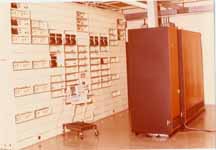Quality of service parameters
General
All delays are specified for normal busy hour load
and expressed, where appropriate, in terms of:
the mean value
the 95% probability value ie, the time interval in
which 95% of packets sent to the network will be responded to by the network.
Delays across the network are measured from the receipt
at the Exchange (PSE) of the last bit of the packet from the DTE to the insertion
of the first bit of the packet into the output queue of the destination PSE.
All figures given only apply to calls wholly set up within the National network.
Call request delay
The call set-up time is defined as the time from
the receipt of the originating exchange of the last bit of the call request
packet to the placing of the first bit of the call connected packet on the output
queue of the calling DTE, but excluding the time from the placing of the first
bit of the incoming call packet on the output queue to the called DTE to the
receipt by the destination exchange of the last bit of the call accepted packet.
The network has been designed to offer a mean call set-up time for a call request packet of length 38 bytes, including the time taken to progress and switch the packet and to record accounting and statistical information, routed over a connection consisting of 5 * 48 Kbit links in tandem, of less than 400ms and for 95% of such calls of less than 480ms.
DATA packet transfer delay
The delay of the DATA packet across UK may include
one or several retransmissions for error correction. This delay is variable
and depends on the routing, the trunk speed, traffic loading etc.
The network has been designed to provide a mean delay
of a DATA packet of (3+128) octets across UK of less than 360ms and the 95%
probability of less than 400ms.
Established Call Clear
The network may clear a call during the DATA TRANSFER
phase because of congestion by sending a CLEAR INDICATION packet to the DTE.
The network has been designed to ensure the probability of this occurrence should
not exceed 6E-6 per second.
Spontaneous Resets
The network may reset the call because of congestion by sending the appropriate indication to the DTE. The network has been designed to ensure the probability of this occurrence should not exceed 6E-6 per second.
Timers
T10 UK value: 60 secs
started: DCE sends Restart
stopped: DTE sends Restart conf
action: send Restart local procedure error
T11 UK value: 180 secs
started: DCE sends Incoming call
stopped: call accept or clear
action: send clear local procedure error
and remote procedure error to distant end
T12 UK value: 90 secs
started: DCE sends Reset indication
action: SVC sends clear indication to local and remote
DTEs with clearing cause of local and remote procedure error respectively
T13 UK value: 180 secs
non CCITT timers
UK value: 90 secs
started: DCE receives restart request
UK value: 180 secs
started: DCE receives call request
UK value: 90 secs
started: DCE receives Reset request
UK value: 90 secs
started: DCE receives Clear request
T20 UK value 180 secs
started when DTE sends a Restart request
terminated when: DTE receives restart conf or restart
action on expirey: DTE retransmits the restart request
and restarts T20 up to maximum or R20 times
T21 UK value 200 secs
started when DTE sends a Call request
terminated when: DTE receives call connected,incoming call,
clear indication or clear
action on expirey: DTE transmits a clear request
packet
T22 UK value 180 secs
started when DTE sends a Restart request
terminated when: DTE receives reset conf or reset ind.
action on expirey: DTE transmits the reset request and restarts T22 up to a maximum of R22 times.
T23 UK value 180 secs
started when DTE sends a Clear request
terminated when: DTE receives clear confirmation
or clear ind action on expirey: DTE transmits the clear request and restarts
T23 up to a maximum of R23 times.
T24 optional use
default value: 60 secs
window status transmission timer
started when DTE sends a packet with a P(R).
terminated when:
action on expiry: DTE transmits a RR or RNR packet
reflecting the current window condition and restarts T24
T25 optional use
default value: 150 secs
window rotation timer
started when DTE sends a DATA packet.
terminated when: there are no outstanding DATA packets
in the window action on expirey: DTE retransmits all DATA packets in the window
and restarts T25 up to a maximum of R25 times
T26 default value: 180 secs
interrupt response timer
started when DTE sends a INTERRUPT packet.
terminated when: DTE receives an INTERRUPT CONFIRMATION
packet action on expirey: DTE transmits a reset request
T27 default value: 60 secs
reject response timer
started when DTE sends a REJECT packet.
terminated when: DTE receives the first retransmitted
DATA packet. action on expirey: DTE retransmits the REJECT packet and restarts
T27 upto a maximum of R27 times.
T28 CCITT 1984 ONLY
default value: 300 secs
registration request response timer
started when DTE sends a REGISTRATION REQUEST packet.
terminated when: DTE receives a REGISTRATION CONFIRMATION
packet. action on expirey: DTE retransmits the REGISTRATION REQUEST packet and
restarts T28 upto a maximum of R28 times.

